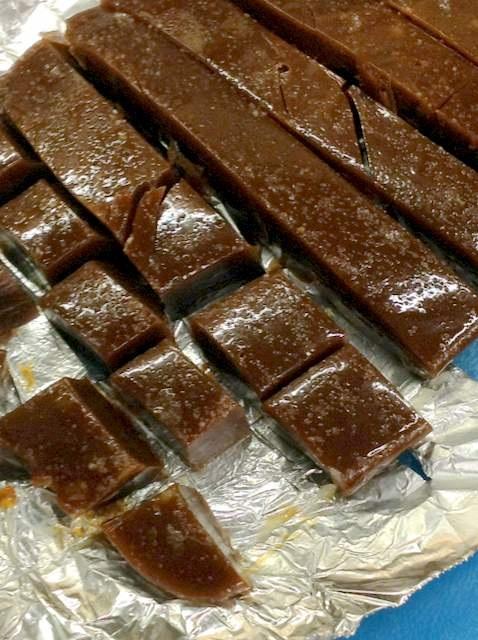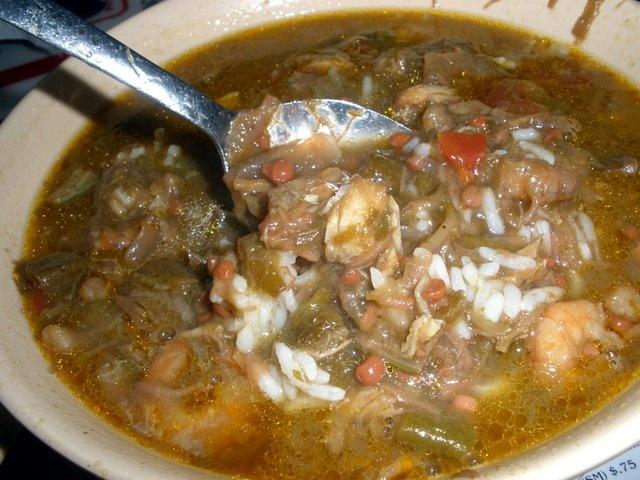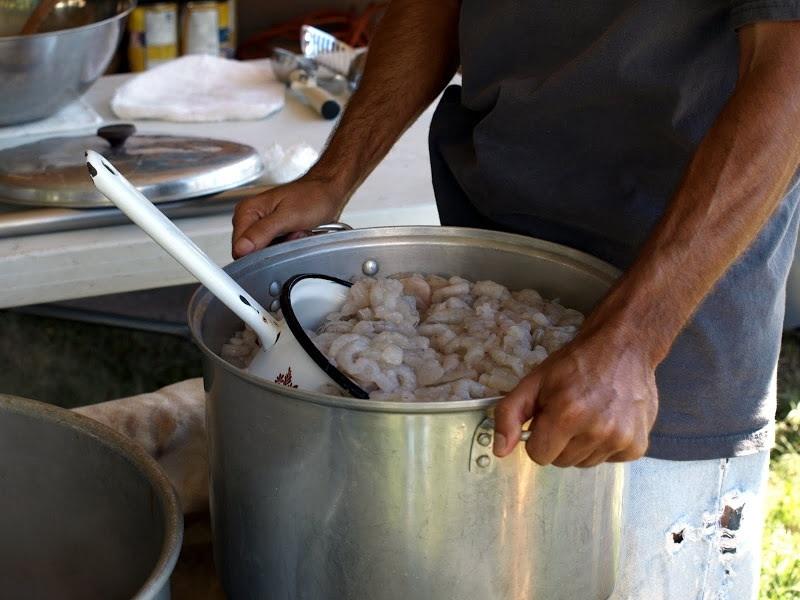
HungryC
-
Posts
1,502 -
Joined
-
Last visited
Content Type
Profiles
Forums
Store
Help Articles
Posts posted by HungryC
-
-
I did not dry cook the sugar...I followed Lebovitz's recipe exactly, except I substituted cane syrup for the corn syrup. But I have used a cast iron skillet to caramelized sugar for Vietnamese caramel sauce (see Andrea Nguyens excellent illustrated recipe: http://www.vietworldkitchen.com/blog/2007/10/caramel-sauce.html )
-
A cast iron skillet is a good and inexpensive tool for dry caramelizing sugar. I made a variation of those Leibovitz salted butter caramels, substituting Steens cane syrup for the syrup in the original recipe. Worked out well, though the caramels softened after a couple of days due to ambient humidity.

-
Use it just like bacon or smoky ham to season a dish. I use it most often to season beans...red, white, purple hull peas, black eyes, or baby green limas (pictured at link) or fresh green beans. It will also make a plain little cream sauce into something delicious.
-
Pepper extract strength can vary widely. I think you're going to need to experiment on this one. Perhaps make small batches of sugar syrup first--you can test the extract's strength drop by drop. Then you won't be wasting all your efforts on a caramel that becomes inedibly hot.
-
I fall back on the Amy's tamale verde and the cheese enchiladas (cheap @ WalMart) when inclement weather (or overwork) traps me in my office, and I'll spring for the more expensive Ethnic Gourmet frozen entrees (saag paneer, usually) if I know I'll be pressed for time. These are about the only ones I've tried that I'd care to repeat. My mother claims that the Lean Cuisine panini are passable, but I haven't tried 'em myself.
-
How is he making his coffee? Blade grinders are fine if he's a French drip man, but if espresso is his thing (or is in his near future), then a blade won't cut it. I'm a fan of Baratza's burr grinders... http://www.baratza.com/ well priced for the quality, and they'll grind fine enough for an espresso machine. And my "local roaster" is Orleans Coffee Exchange: http://www.orleanscoffee.com/ Orleans will send you whole beans from a variety of roasts, or you can get a "subscription" of beans delivered to his door. I drink Orleans Coffee's espresso crema or italia roast nearly every single AM.
-
This thread reminds me I need to reorder some Rio Zape beans...quite possibly the most delicious dried beans I have ever cooked.
-
Contact your local restaurant association for referrals....but start with your backyard, so to speak. Do you have favorite restos? Pitch to those chefs first, aiming for products already used on their menus. Do some price research as well....what is the prevailing wholesale price for your items in your market? Are you really cheaper than, say, Restaurant Depot or Sysco or the average produce wholesaler in your area? Know before you walk in the door to talk to a chef...he/she won't appreciate having his time wasted if you claim to be cheaper but have no real clue about prevailing area prices or can't provide a sufficient volume on a consistent basis.
-
Good cheese, bread, and a green salad. Or something homemade, excavated from the freezer...
-
Anyone ever ran the very small ones through a spice grinder and maybe crusted something with them?
Depending on how "dried" your shrimp are, you might fare better with a mortar and pestle rather than a spice grinder...some are pretty flexible, not quite jerky-like in texture.
I can buy powdered dried shrimp at WalMart or just about any supermarket, so I don't need to run them through a spice grinder. You can generally find small whole shrimp, crushed 'fluff' shrimp, and shrimp powder, packaged in little cello bags, stapled to a large cardboard display card. Local dried shrimp are most often sold w/o shells--the imported Asian stuff is usually shell-on.
Here's a link to a 100+ year old dried shrimp maker in Houma, LA: Blum & Bergeron's website will give you an idea of the "usual" sizes and varieties available in south Louisiana.
And here's an interview (see video & overview here, and transcript here) conducted by Sara Roahen/Southern Foodways Alliance with Robert Collins, a dried shrimp producer in Grand Isle, LA.
ETA: the dried shrimp tradition in Louisiana has its roots in fishermen from Manila, who dried shrimp in the sun & open air on raised platforms. A marshland community called Manila Village, north of Grand Isle, was well known for "dancing the shrimp", a custom of walking on the nearly dried shrimp in order to break off the shells. Photo of "dancing the shrimp" here; more background on Filipinos in LA here. Color-enhanced arial photo of Manila village, showing the shrimp drying platforms here.
-
Perhaps John Besh? His Lüke restaurant here hasn't been communicated well to me by my friends.
It's easy to lose your edge in this business and if the chef/owner isn't ALWAYS around to make sure things are up to par you start to see a slide no matter how talented the Exec is. AT that point they're just cooking his food.
But I also think there is the "jaded" aspect to it as well. That is why I try to patronize my long-time favorites infrequently and do my own cooking. If I go too often the dishes and service just don't seem as good as my memory serves. Familiarity breeds contempt.
Can't agree with the Besh assessment, as his other places--Domenica, Borgne--are certainly at the top of the game locally. I suggest that Paul Prudhommes K Paul's is but a sad shadow of its former self.
-
Dried shrimp have a concentrated flavor of their own. It is not precisely fresh shrimp flavor...it has a slightly fermented tang, a concentrated essence without the sweetness of fresh shrimp. Kinda like salt cod vs the fresh fish. Rehydrating the shrimp yields a soft, slightly mealy texture, but dried shrimp are quite small, so you dont get much shrimp in any one bite. Dunno what purpose a separate stock would serve, as they're not lacking in flavor. In my culinary tradition, they're not used as a principal protein in a dish, but rather as flavoring.
I do wonder about dry toasting the already dried shrimp, in a similar fashion to dry toasting shrimp paste in SE Asian cooking.
-
Pounds of micro greens, way cheaper than other sources.
-
I'm annoyed by the creep of marketing-speak into restaurant dining rooms. I don't want to hear about your "wine program" or "cocktail program". It's a wine list, or a cocktail menu....when I hear the word program applied in this context, it automatically makes me think about managed costs and markup, which erases any feelings of genuine hospitality. Leave the b-school jargon behind, please. Ditto for the kitchen jargon delivered by waiters in describing specials...."fired to medium rare" or "baked off to golden brown".
-
Slow cookers are inexpensive, and to make them even cheaper, they're often found at thrift stores.
-
Dried shrimp in SE LA Cajun cooking used to be pretty common, prior to freezing of shrimp. How else would you make seafood gumbo in the dead of winter? Many old school cooks still use dried shrimp to flavor gumbos and stews. I'm especially fond of a dried shrimp and potato stew (with a roux). Dried shrimp also show up in mirliton (chayote) dishes, cooked with white beans (navy beans), and are eaten out of hand as a snack. Powdered dried shrimp are a powerful boost to any seafood stock. In short, use em to deliver shrimp flavor to the backbone of a dish in the same way you would use smoked meats to flavor a dish....
-
I checked it out from the library as an e-book....not exactly what I expected. Lots of "lite" science, author's musings, and stuff that has been better covered elsewhere. Many regular posters on this site can write a better/more authoritative book on the same topics.
-
Whole foods have more indigestible fiber. Ergo, an equally caloric hunk of whole wheat will deliver fewer digested calories to the eaterthan an equally caloric highly processed white bread...because calorie counts are lab generated measurements using incineration, not a measure of how many calories a human gut can get out of a food.
-
Goes to show how much regional variation exists....I have dozens and dozens, and not a single decent one is in color. The full color ones are all from awful, student-ghetto Chinese joints.
-
Why would you pay any more than the cost of a photocopy? The going rate at copy shops for black and white is 10 cents per page for less than a thousand, 5 cents for more than 1k, with big price breaks as the volume increases. Color is wasted on takeout menus, IMHO. If you have something that requires offset printing, spend a few bucks on a decent graphic designer who can create a copy friendly version.
-
It's more a factor of your equal parts oil and flour roux. You can make a roux with a smaller proportion of oil, but it requires careful attention as it is easier to burn (try the microwave method for a drier roux). Also, I find that olive oil rouxs separate more easily than a roux made with part rendered bacon fat or lard or rendered chicken fat. I generally use peanut oil, it separates pretty readily as well. This shoe thread is making me crave a chicken, oyster, and sausage gumbo.
ETA: medium grain, slightly sticky rice is the rural Cajun preference, or long grain cooked on the soft side. Definitely NOT the typical nasty converted style separate grains....it should hold together in a mass when scooped into a bowl, not fall apart like pilaf.
-
Yes, the skin and fat on top are typical, especially if you cooked it for five hours...that's a loooong time. I just stir the skinback into the gumbo. The fat is coming from the sausages and the roux. Some skim every bit of the oil off, other like a little bit of oil atop each serving. I was with you until you put tomatoes in it!
I'd cook the roux, veg, and water for a While, then put in some of the crabmeat for a while (maybe an hour), then add the rest of the seafood and cook for a half hour or so. Shrimp and crab in gumbos aren't al dente and perfect....they're well cooked and integrated into the gumbo. Restaurant technique calls for making a long cooked base then adding seafood near the time of service, but home style gumbos in south LA feature long cooked seafood.
Here's a seafood and okra gumbo from The bayou Lafourche area...note the slight sheen of oil, the shreds of long cooked crabmeat, and the thin, souplike consistency, all indicative of the locale's typical seafood gumbo style.
-
One of these would do the trick
Considering the long-handled sauce-pan approach- holding a weighty sloshing hot liquid at the end of a sauce-pan and then extending it's length further sounds extremely awkward and hazardous. It'll have to be held uncomfortably with two hands most likely pouring will be difficult in the best scenario. Maybe a trip to the ER in the worst.
My $0.02
I'm not suggesting the use of a heavy high quality pot....a dime store enameled steel saucepan is lightweight, only takes one hand even when full, and is easier to hold than a stainless steel ladle. Here's my little pot in action, transferring pounds of raw shrimp into a large gumbo pot. It is equally useful in skimming fat off the top of a boiling 80 qt or quickly dipping out lots of boiling liquid. No burns or ER trips, at least 20 years + of use.
-
I make Cajun style hogsheads cheese, so my seasonings are salt, black pepper, cayenne pepper, thyme, onion, parsley, and plenty of green onion tops. But this regional head cheese style calls for a bit of pork liver, so that's almost a seasoning in itself. Recipe: http://bouillie.us/2009/06/17/headcheese-without-a-head/



Variations on Caramels
in Pastry & Baking
Posted
Steens is somewhere between Lyles and molasses...it isn't as bitter as molasses, but it does have the browned, vegetal notes similar to molasses, whereas I find Lyles is softer, less assertive. Steens is a local product for me, so I use it in all sorts of things from vinaigrette to turkey brine to pancake topping and on yogurt.